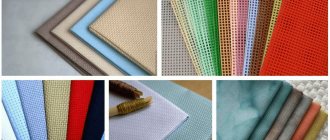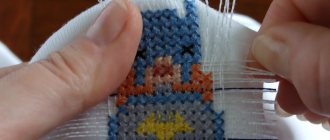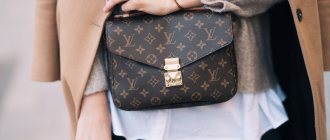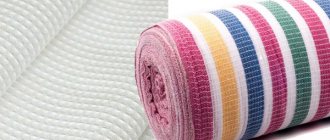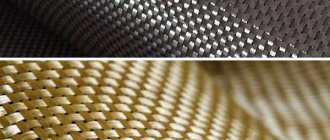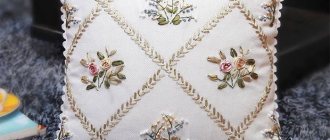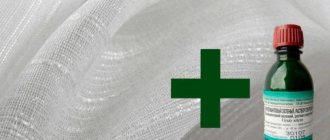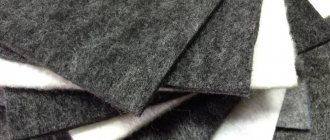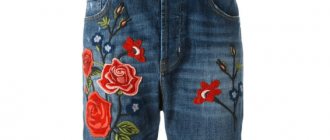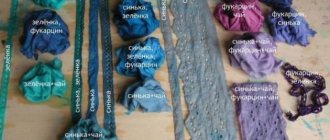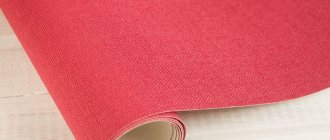Embroidery fabric is used for any type of embroidery. The canvas is purchased in specialized departments for needlework. Sometimes the material is included in the kit along with threads, a set of needles and a finished pattern. To buy fabric for cross stitch, for example, you need to know in advance the pros and cons of each type of material and its features. For comparison, you can try several options and choose the one that suits you best. The same applies to other techniques.
What fabric is used for cross stitch?
According to the type of weave of threads, cross stitch fabric is divided into two types - canvas and linen. Canvas is more suitable for beginner needlewomen; it is easier to embroider on it. There is a kind of marking on this material. Externally, the canvas looks like a waffle towel. Its surface is divided into small squares, along the edges of which there are already holes for needles.
The embroidery fabric has a uniform structure and does not have clearly visible markings. This option is chosen by skilled women who have already mastered embroidery and acquired considerable experience in this matter. Factories produce canvas and linen from different materials. Each manufacturer tries to improve the quality of fabric by introducing its own developments.
Varieties of canvas
When purchasing canvas, you need to take into account what kind of embroidery it is intended for. It is necessary to take into account the purpose of the finished product and the thickness of the threads. The following types of canvas can be found on sale:
- overhead - used when embroidering on fabric with uneven weaving, it is placed on top of the fabric, and after completion of the work it is pulled out, removing one thread at a time;
- water-soluble - is a transparent mesh; when the embroidery is ready, the canvas is dissolved by soaking the fabric in water at a certain temperature;
- plastic – used for embroidery of three-dimensional decorations (souvenirs, Christmas tree decorations);
- Stramin is a rigid canvas with large cells, which is used for embroidery with wool.
You can determine the size of the canvas for a specific embroidery by calculating it based on the number of crosses and adding 5 cm for the allowance on each edge. To prevent the material from fraying, it is covered with threads to match the main color. The finished work will look neat only if you monitor the thread tension. Embroidery should not wrinkle the fabric or look too loose.
The “Aida” canvas with clearly marked cells and distinguishable holes is very popular among craftswomen. Working with her is a pleasure. The material is available in a wide range of colors, has different densities and different sizes of holes for needles. For beginner embroiderers and children, for example, Aida canvas No. 7 with large perforations is suitable.
The best manufacturers
Zweigart is considered the best manufacturer of embroidery fabrics . Their Aida canvas has gained wide acceptance due to its versatility in size and the good density of its 100% cotton backing.
The fabric has a wide color palette; you can buy it in a roll or in the form of a tape with a treated edge. The most popular fabrics of them are the following.
- Aida No. 8 - suitable for teaching beginners and children; 32 cross stitches can fit in 10 cm of this canvas.
- Aida No. 16 - fabric twice thicker than No. 8, allows you to embroider with two threads.
- Aida No. 20 - allows you to perform more detailed embroidery with one thread; 72 crosses are placed in 10 cm of this base.
Chinese cross stitch kits are also popular. They include canvas, embroidery pattern and floss, and are good value for money.
These kits have everything covered, so if embroidery is your hobby, the kits will be an ideal option for you, as well as if you have a goal to improve your skills in this craft.
Uniform weave fabric
A fabric of uniform weave is called “uniform” by needlewomen. It is made from cotton and linen threads. This fabric is suitable not only for cross stitch, but also for working with other techniques, for example, satin stitch. You can distinguish linen from cotton material by the structure of the threads. Linen threads have different thicknesses; linen fabric looks more natural. The cotton uniform has a uniform texture.
Despite the fact that working with linen requires more skill, each embroiderer sooner or later tries to acquire this skill. Cross stitch on canvas looks more natural. In areas not sewn with thread, holes and cells are not noticeable, as when using canvas. In addition, it is more convenient to make fractional crosses on the canvas. Having mastered cross stitch on a uniform pattern, no craftswoman will ever want to return to a more primitive version.
The fabric can also consist of mixed fibers. For example, viscose or rayon is added to cotton. Cotton and linen fibers are often combined, combining them in equal proportions. Among the mixed fabrics for embroidery, the popular brands are “Quaker”, “Belanna”, “Floba”, “Viena”, “Lugana”.
Non-woven base
The peculiarity of such materials is the absence of interlacing of threads. It is made from synthetic fibers that are joined by heat sealing or adhesives.
Used for embroidery:
- interlining: a paper-like material used in embroidery using counting techniques, satin stitch, and beads. It can be regular or water-soluble;
- vinyl canvas: resembles plastic, but is flexible and ductile. Used in decorating accessories (cosmetic bags, covers, cases, wallets), toys, crafts;
- transparent film: water soluble material. Makes it easier to embroider on complex fabrics, including fur, terry, fleecy textiles, and knitwear. Helps achieve a clear, stabilized image.
Perforated paper
Most often, paper with perforations corresponds to Aida canvas No. 14. Sheets of other formats can also be found on sale. During the embroidery process, the craftswoman should use 1-2 threads. More threads may damage the perforation. Due to the fragility of paper, working with it has its own characteristics.
The threads should be soft and silky. Also, in this case, it will be inconvenient to work with a scheme that provides a large number of colors. Paper is often used as a basis for embroidery where fabric is not suitable, for example, for embroidering bookmarks or postcards.
Calculating the outline
When you have chosen the image to be embroidered, whether it will be openwork fabric or dotted embroidery, as well as all the necessary materials, then you can begin to calculate the required amount of base for cross stitch. This will require some knowledge:
- you need to know the size of the future painting. The size is determined by the number of crosses to be embroidered in length and width;
- make the calculation using the following formula. If 55 crosses are 10 cm, 100 crosses are X cm. Then X will be equal to 100 * 10/55 and equal to 18.2 cm;
- then you need to provide for the presence of embroidery fields on all sides.
You can adhere to a certain rule according to which the width of the margins should not be less than 5 cm on each side. This is necessary so that later the embroidery on the fabric fits perfectly into the frame. Once the calculation of the required material is made, it is necessary to cut along the cells. Then take a light thread and make a bias stitch along all the edges. Now all that remains is to come up with a name for the future picture.
Fabrics for embroidery in other techniques
Cross stitch is one of the popular types of needlework, but besides it there are many other techniques. Some people like Luneville crochet embroidery, others like satin stitch, chain stitch or tapestry stitch. The material is selected based on the specific task.
Luneville embroidery
Luneville embroidery does not require canvas; this technique involves working with a special crochet hook. The patterns are embroidered on transparent and translucent fabrics. From inexpensive materials you can choose polyester or silk organza, crepe, or a special “Italian” mesh. Thick fabrics are more suitable for beads - muslin, velvet.
Satin embroidery
There are many types of suitable fabric for satin stitch embroidery; it is not at all necessary to take canvas. The correct stitching technique is of greater importance here. They should lie flat, without gaps. For satin stitch, regular weave fabric, denim, burlap, wool, chintz, satin, drape are suitable. For beginners, it is advisable to choose a light material for the base, on which the translated drawing is better visible.
Tapestry seam
For embroidery with a tapestry stitch, a special tapestry canvas is purchased. In this case, special requirements are imposed on the material - it must have a rigid mesh structure. This base is usually made of cotton or linen. As a canvas, you can use plastic or vinyl mesh, Stramin, or Penelope fabric. The canvas for the tapestry should have large cell sizes.
Chain stitch
The chain stitch is considered a universal embroidery method. They are mainly used to embroider ready-made clothes. Colored threads are attached to the surface in the form of chains. Silk fabric, cotton, leather, suede, felt material, jeans, knitwear, corduroy can be used as a base. At the same time, the thickness and texture of the threads are selected so as to match the fabric.
Richelieu
This embroidery technique is suitable for almost any fabric. However, you need to take into account the features of the design and the purpose of the item. Delicate lace pattern is suitable for thin fabrics. A large drawing is placed on a thick canvas.
If you plan to decorate a tablecloth, curtains, or napkins with cutwork embroidery, use linen or thick cotton. To embroider rugs and panels, they use drape, wool, canvas, burlap, and cloth. To create embroidery on a blouse or dress, silk and cambric are used.
Embroidery ribbons
A wide range of fabrics are suitable for ribbon embroidery. These may not be too dense materials made of cotton, linen, silk, or wool. Mixed fabric and knitwear are also suitable. The main requirement for the fabric is that it be strong enough, because the finished embroidery will be voluminous and heavy.
The material can be smooth, patterned, or pile. The design on printed fabrics can be used as a pattern for embroidery. It is advisable that the material be wrinkle-resistant, because ironing it together with embroidery will be problematic.
The use of canvas is necessary in some cases, but in others it will be superfluous. It all depends on the embroidery technique. By choosing the right material for a specific type of needlework, you can get the perfect job. Of course, provided that the embroiderer has mastered the skill perfectly.
Varieties of smooth surface
You can embroider designs of any size, but for the first steps it is better to select small ornaments or pictures that can be filled in width with a satin stitch in one stitch. You can start with simple drawings of berries, leaves, twigs or flowers. And of course, it’s better to use a ready-made set.
Simple stitch
This satin stitch is double-sided, that is, the embroidered design looks the same on both sides of the canvas. All elements of the pattern are made separately with stitches lying tightly next to each other. The size and direction of sewing in this case can be any. This type of satin stitch is best for a beginner!
White with covering White satin stitch embroidery
The threads for this look are silk or floss, but always white, and the embroidery is done on white or light-colored fabric. Such patterns look very elegant and gentle; needlewomen use them to decorate clothes, bed linen, towels and tablecloths.
Artistic colored surface (tone)
The stitch is performed obliquely and without flooring. For this satin stitch you will need colored floss threads or silk. By using darker embroidery in the center and lighter embroidery as you approach the edge, you can make the picture three-dimensional and complex.
Chinese smooth surface
The basis for this embroidery is dark satin or silk fabric. Traditional Chinese and Japanese motifs predominate: fish, animals, birds and nature. It is better to postpone this method until you gain experience and can perform a more complex level of work.
Russian (Vladimir) smooth surface
The design is embroidered along the contour, with long stitches running along the front side, and only intermittent short lines are made on the back side. The Vladimir smooth surface is dominated mainly by monochromatic colors - red, green, yellow, blue.
What does the canvas number mean? Russian and international classifications of Aida canvas
The canvas number indicates the number of cells (or threads) per 1 cm or 1 inch (2.54 cm): the higher the number, the smaller the canvas cell. Why? Let's figure it out now. The word "count" comes from the English word "count" (to count). There are TWO classifications in the numbering (count) of the outline: • international (European) • Russian
International classification
Based on the number of cells per 1 inch (2.54 cm). How many cells (or threads) fit in 1 inch, this is the number (count) of the canvas you will get in the end. For example, Aida 14
means that 14 squares fit in 1 inch;
Linda 27
- there are 27 threads in 1 inch.
Russian classification
Here we rely on our native centimeter. The number of cells (threads) in 1 cm is equal to the number of the canvas. Example - Aida 5.5 contains 5.5 cells in 1 cm of canvas.
Correspondence table for Aida canvas
I present this correspondence table, since “Aida” canvas is one of the most recognized fabrics for cross stitch by needlewomen in Russia. International numbering = Russian numbering: Aida 8 = Aida 3.2 Aida 11 = Aida 4.3 Aida 14 = Aida 5.5 Aida 16 = Aida 6.3 Aida 18 = Aida 7.0 Aida 20 = Aida 7.9
Cotton
Cotton fabric differs from linen because it has even threads and can come in different colors and sizes.
Jubilee
– soft fabric with size 28ct
Linda
or
Evenweave -
a lightweight fabric with a size of 27ct. It is perfectly processed and drapes well, so clothes and bed linen are sewn from it, as well as napkins, tablecloths, etc. When working with two threads, you will get an image similar to working on Aida 14ct, but you will have an additional opportunity: Linda square cross can be divided into two narrow ones.
Davosa
– soft fabric with size 18ct (71 crosses per 10 cm).
Janina is a 22ct fabric, perfect for counted satin stitch.
Annabelle
— fabric with size 28ct is a little shiny, and the thickness of its threads is uneven.
Oslo
– this fabric is made from mercerized cotton, thanks to which it acquires excellent strength and a beautiful shine. It has a large width of 1.7 m and is therefore very popular for embroidered tablecloths.
Linen
Linen fabrics are considered one of the best. Firstly, they are completely natural, secondly, they are durable, and thirdly, they look very noble. Linen is actively embroidered with cross stitch, tapestry, stitches and the hardanger technique. To get a good image on linen, embroidery goes through 2 threads. Typically these fabrics have a high count. The most popular are Cashel 28, Belfast 32, Newcastle 40. In addition, you can find linen 18, 25 and 26 counts.
Linen
Stramin
Stramin is a very dense material for creating tapestries, paintings, and carpets. It is also called carpet canvas, since in appearance it resembles a coarse mesh. As a fabric for embroidery, Stramin is expensive, so it is often replaced with construction mesh, which is designed for reinforcement under plaster. Less price, same effect. For comparison: 1 m of stramine costs the same as a ten-meter piece of construction mesh.
Stramin
Net
